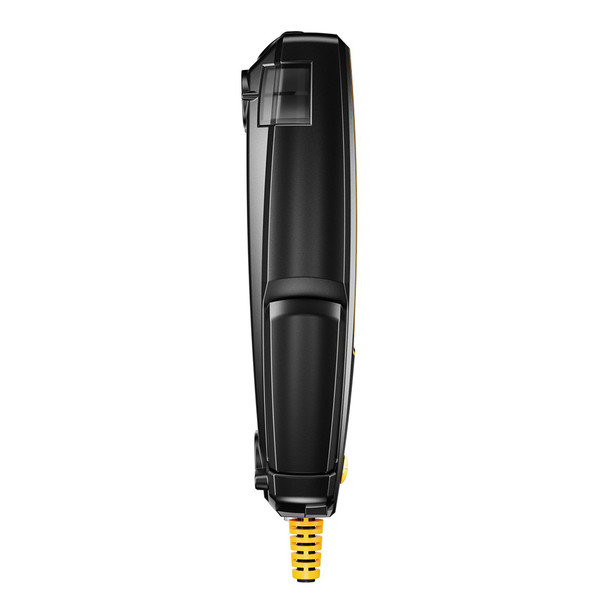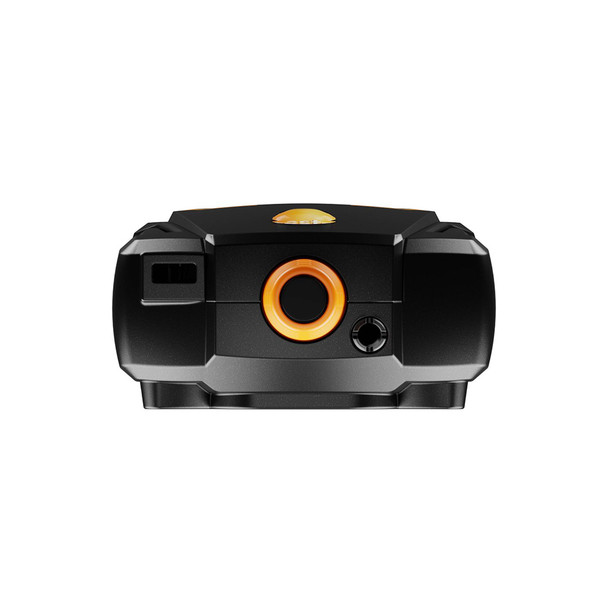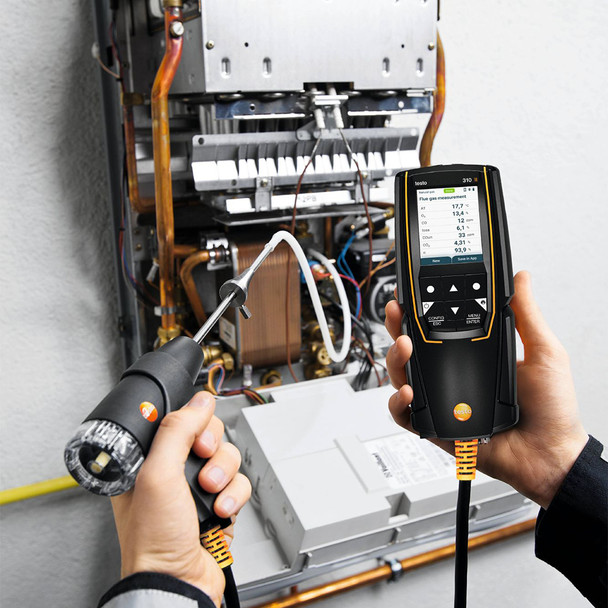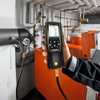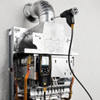Description

Testo 310 II - Residential Combustion Analyzer Printer Kit with Configurable Display and Smart App Functionality
Flue gas analysis, the EASY way!
Also available without Bluetooth Printer Reporting Kit.
The new testo 310 II flue gas analyzer combines simple functions with a high level of measurement accuracy, and is perfect for all basic measurements on heating systems. Long battery lifetimes of more than eight hours guarantee the analyzer is ready. Simultaneous, individual measurement and display of the measurement parameters in the instrument's high-resolution display are easily possible. The display can be easily configured via the testo Smart App and translates to the 310 II. Its easy handling and compact design make the testo 310 II a robust too for daily work - even when things get rough.
The printer with Bluetooth interface, specially developed for the testo 310 II, allows you to create clear reports on site as required. The current measurement value can be printed out of any measurement menu during or after the measurement. Via the simple connection to the testo Smart App, further measurements as well as digital documentation, data transfer and digital customer data management can be performed simultaneously. The testo 310 II offers all advantages of electronic flue gas measurement in high quality at a perfect cost-benefit ratio
Key Features & Benefits
- Simultaneous, individual measurement and display of all relevant measurement parameters (O2, CO, CO2, flue gas and ambient temperature, CO environment, draft and pressure)
- Display configurable via the testo Smart App
- Simultaneous, additional measurements via the testo Smart App (e.g. gas flow pressure, flow and return temperature)
- Easy and intuitive menu guidance
- Data documented and sent digitally via testo Smart App
- Digital customer data management via testo Smart App
- Rechargeable lithium battery for over 8 hours of operation
- Robust construction
- Sensor zeroing in 30 seconds
Download the Testo Smart App for your Android or iOS devices today!
Additional, simultaneous measurements, digital documentation, data transfer and digital customer data management via the testo Smart App.
Draught measurement in the flue gas duct
Draught measurement is actually a differential pressure measurement. This differential pressure occurs between two
sub-areas as a result of a difference in temperature. This is turn generates a flow to compensate. In the case of
flue gas systems, the difference in pressure is an indicator of the “chimney flue draught”. This is measured between
the flue gas and ambient air at the measurement orifice at the core of the flue gas flow.
To ensure the flue gases are safely transported through the chimney there must be a differential pressure (chimney
flue draught) for boiler systems that work with low pressure.
If the draught is permanently too high, the average flue gas temperature increases and therefore flue gas loss. The
level of efficiency drops.
If the draught is permanently too low, oxygen may be lacking during combustion, resulting in soot and carbon
monoxide. This will also cause a drop in the level of efficiency.
Ambient CO measurement in the heated environment
Carbon monoxide (CO) is a colourless, odourless and taste-free gas, but also poisonous. It is produced during the incomplete combustion of substances containing carbon (oil, gas, and solid fuels, etc.). If CO manages to get into the bloodstream through the lungs, it combines with haemoglobin thus preventing oxygen from being transported in the blood; this in turn will result in death through suffocation. This is why it is necessary to regularly check CO emissions at the combustion points of heating systems, and places often frequented by people (in our case, where the combustion systems for hot water generation are), and in the surrounding areas.
Measuring the flue gas parameters of the burner (CO, O2, and temperature, etc.)
The flue gas measurement for a heating system helps to establish the pollutants released with the flue gas (e.g.
carbon monoxide CO) and the heating energy lost with the warm flue gas. In some countries, flue gas measurement is a
legal requirement. It primarily has two objectives: 1. Ensuring the atmosphere is contaminated as little as possible
by pollutants; and 2. energy is used as efficiently as possible. Stipulated pollutant quantities per flue gas volume
and energy losses must never be exceeded.
Measurement in terms of results required by law takes place during standard operation (every performance primarily
using the appliance). Using a Lambda probe (single hole or multi-hole probe), the measurement is taken at the centre
of flow in the connecting pipe (in the centre of the pipe cross-section, not at the edge) between the boiler and
chimney/flue. The measured values are recorded by the flue gas analyzer and can be logged either for print out or
transfer to a PC at a later stage. Measurement is taken by the installer at commissioning, and if necessary four
weeks later by the flue gas inspector/chimney sweep, and then at regular intervals by the authorised service
engineer.
Measuring pressure on burners (nozzle pressure, gas flow pressure, etc.)
Standard readings taken during services of domestic heating systems include checking the gas pressure on the burners. This involves measuring the gas flow pressure and gas resting pressure. The flow pressure, also called supplied pressure, refers to the gas pressure of the flowing gas and resting pressure of the static gas. If the flow pressure for gas boilers is slightly outside the 18 to 25 mbar range, adjustments must not be made and the boiler must not be put into operation. If put into operation nonetheless, the burner will not be able to function properly, and explosions will occur when setting the flame and ultimately malfunctions; the burner will therefore fail and the heating system will shut down.
Specs
| Parameter | Measuring Range | Accuracy | Resolution |
| Temperature (Flue gas) | 32 to 752 °F (0 to +400 °C) |
±1.8 °F (32° to 212 °F) / ±1 °C (0 to +100 °C) ±1.5 % of mv (> 212 °F) / ±1.5 % of mv (> 100 °C) |
0.1 °F (0.1 °C) |
| Temperature (ambient) | -4° to 212 °F (-20 to +100 °C) |
±2 °F (±1 °C) |
0.1 °F (0.1 °C) |
| Draft measurement | -8 to +8 InH₂O (-20 to +20 hPa) |
±0.01 InH₂O (-1.20 to +1.20 InH₂O) ±0.03 hPa (-3.00 to +3.00 hPa) ±1.5 % of mv (Remaining Range) |
0.01 InH₂O (0.01 hPa) |
| Pressure measurement | -16 to +16 InH₂O (-40 to 40 hPa) |
±0.2 InH₂O (±0.5 hPa) |
0.1 InH₂O (0.1 hPa) |
| O2 measurement | 0 to 21 vol.% | ±0.2 vol.% | 0.1 vol.% |
| CO measurement (without H2- compensation) | 0 to 4000 ppm | ±20 ppm (0 to 400 ppm) ±5% of m.v. (401 to 2000 ppm) ±10% of m.v. (2001 to 4000 ppm) |
1 ppm |
| Ambient CO measurement | 0 to 4000 ppm | ±20 ppm (0 to 400 ppm) ±5% of m.v. (401 to 2000 ppm) ±10% of m.v. (2001 to 4000 ppm) |
1 ppm |
| Efficiency testing (Eta) | 0 to 120% | - | 0.1% |
| Flue gas loss | 0 to 99.9% | - | 0.1 % |
| General Specifications | |||
|---|---|---|---|
| Power supply | Rechargeable battery: 1500 mAh, Power supply: 5V/1A | ||
| Display | Graphic 7-line display | ||
| Memory | Reports saved within testo Smart App | ||
| Weight with probe | Approx. 1.5 lbs (660 g) | ||
| Dimensions | 8 x 3 x 2 in. (201 x 83 x 44 mm) | ||
| Operating temperature | 23° to 113 °F (-5 to +45 °C) | ||
| Storage temperature | -4° to 122 °F (-20 to +50 °C) | ||
Includes
- (1) Testo 310 II Combustion Analyzer
- (1) Bluetooth printer
- (1) 7" Probe with cone
- (1) Rechargable Li-Ion battery
- (1) Power Supply and cable
- (1) Silicon hose for pressure measurement
- (5) Particle filters
- (1) USB-C cable
- (1) Hard Case
- (1) Cert of Conformity







